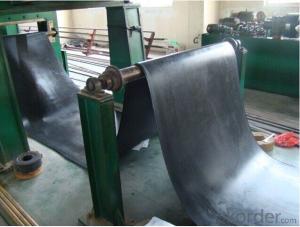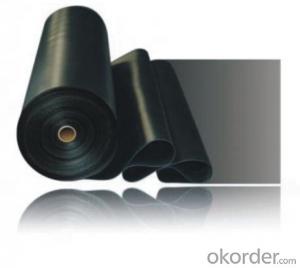Black EPDM Rubber Waterproof Swimming Pond Liner
- Loading Port:
- Qingdao
- Payment Terms:
- TT OR LC
- Min Order Qty:
- 2000 m²
- Supply Capability:
- 100000 m²/month
OKorder Service Pledge
OKorder Financial Service
You Might Also Like
EPDM waterproofing roofing membrane
1. Introduction:
1.Product composition
This waterproof coiled material is of high elasticity with best performance among high polumer
waterproof coiled material in the world.It is also the most typical one in the world.Waterproof
coiled material made of ternary ethylene-propylene rubber is produced withthe use of the most advanced contiuous extrusion and vulcanization technology and related
equipments which are specially designed for production of such product.It is good in compactness,
without bubble and performance difference in length and breadth,perfomances reach or exceed the demands of GB18173.1-2000 standard.
2. Advantages of epdm membrane
1>Excellent antiaging performance, service life up to 50 years
2>Working well with in 40C to 100C,it canbe constructed with a single layer in ambient temperature.
3>Waterproofing on various kinds of underground project,industrial of civil buildings and structures.
4>high extension rate, high tensile strength, small size changes at heat treatment
5>Good plant roots penetrability resistance and can be made waterproofing layer of planting roof
6>Special modified molecular structure ,effectively resolving the current domestic and foreign glue joint problem .
7>Good low temperature flexibility, and good performance of adapting to ambient temperature changes.
8>Convenient application ,solid joint, no environment pollution
9>chemical corrosion Resistance, can be used for special occasions
10>Convenient maitenance, low cost.
3. Application Scope of epdm membrane
Widely used in roofs, basement, toilet ,swimming pool, and all kinds of industry and civil building
waterproofing, reservoir, vivicism, bridge, underground, tunnel and dam waterproofing ,especially
to the keystone waterproofing projects which is durability, high corrosion resistance and easy
deformation.
4. Technical Data:
The item name | Indication | Applicable test items | ||||
Tension Strength (MPa) | Normal temperature≥ | 7.5 | GB6.3.2 | |||
60°C≥ | 2.3 | |||||
Elongation at break | Normal temperature≥ | 450 | ||||
-20°C | 200 | |||||
Tear strength N ≥ | 25 | GB6.3.3 | ||||
(0.3Mpa.30 min)Water tightness | No seeage | GB6.3.4 | ||||
Flexibility at low temperature ≤ | -40 | GB6.3.5 | ||||
Heat expansion (mm) | Extended ≤ | 2 | GB6.3.6 | |||
Contraction ≤ | 4 | |||||
(80°C×168h) | Fracture tensile strength retention %≥ | 80 | GB6.3.7 | |||
Hot air ageing | Keep rate tore elongation | 70 | ||||
%≥ | ||||||
Alkaline [10%Ca(OH)2Normal temperature×168h] | Fracture tensile strength retention %≥ | 80 | GB6.3.8 | |||
Keep rate tore elongation%≥ | 80 | |||||
Ozone aging | — | GB6.3.9 | ||||
Artificial climate ageing | Fracture tensile strength retention %≥ | 80 | GB6.3.10 | |||
Elongation at break %≥ | 70 | |||||
Bond peel strength | Standard test condition | 1.5 | GB6.3. | |||
4. Product Show:
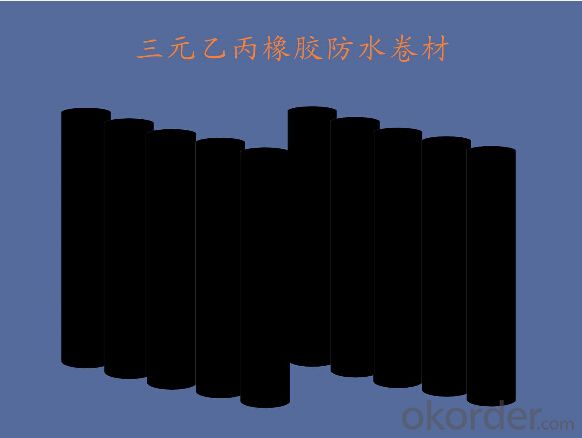
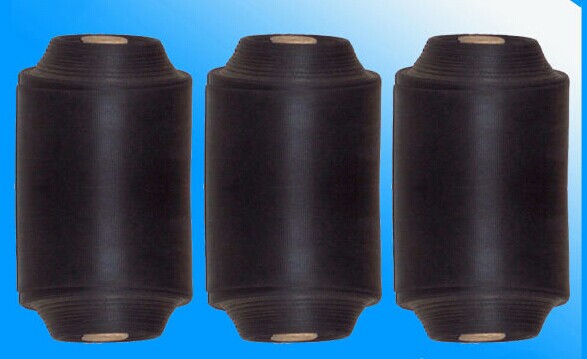
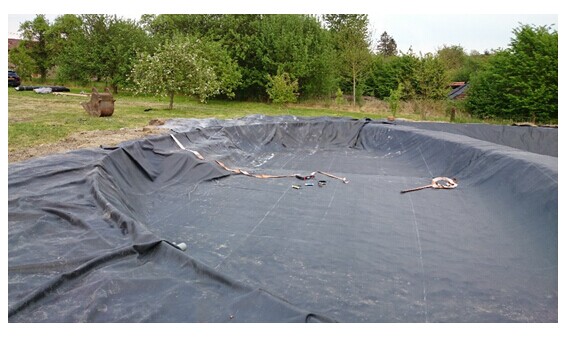
- Q:How does a waterproofing membrane handle moisture from the ground?
- To effectively manage moisture from the ground, a waterproofing membrane is designed to create a barrier that stops water infiltration. It is typically constructed using impermeable materials like rubber, bitumen, or modified asphalt. When correctly implemented, the membrane forms a continuous, watertight layer that prevents water from seeping through the foundation or walls. Typically, the membrane is placed on the exterior side of a building's foundation, where it serves as a protective shield against groundwater. It is applied directly onto the concrete or masonry surface, forming a seamless and durable waterproofing layer. To ensure its long-term durability, the membrane is then covered with a protective layer, such as soil or backfill. In addition to being impermeable, a waterproofing membrane also incorporates features that enable it to handle moisture effectively. For example, it may include built-in channels or dimples that facilitate the drainage of water away from the foundation, preventing the accumulation of hydrostatic pressure. Some membranes even possess self-healing properties, allowing them to seal minor punctures or cracks that may develop over time. Overall, a properly installed waterproofing membrane serves as a dependable barrier against ground moisture. It safeguards the structure from water damage, prevents the growth of mold and mildew, and maintains a dry and healthy indoor environment. However, it is crucial to ensure correct installation by adhering to the manufacturer's guidelines and seeking assistance from experienced professionals to guarantee its effectiveness.
- Q:Are waterproofing membranes resistant to gasoline?
- Yes, waterproofing membranes are generally resistant to gasoline. Most waterproofing membranes are designed to be chemically resistant and can withstand exposure to various chemicals, including gasoline. However, it is important to note that the level of resistance can vary depending on the specific type of membrane and its composition. Some membranes may offer better resistance to gasoline than others. Additionally, prolonged exposure to gasoline can still potentially damage or degrade the membrane over time, so it is always recommended to take necessary precautions and avoid prolonged exposure to harsh chemicals.
- Q:Is the asphalt waterproofing membrane facing the side?
- Because there are many types of self-adhesive waterproofing membrane, their use and construction methods are different, there are two main methods. 1, the normal self-adhesive paving method: the film directly paving or polymer cement cement wetting method, paste in the grass-roots level. The bottom of the floor floor of the building, in the concrete cushion with cement mortar leveling, and then the coiled surface of the membrane down, paste in the leveling layer, the roll surface pouring 50 thick stone concrete protective layer, Floor concrete. Wall construction, the film directly attached to the basement wall panels, and then do the protective layer on the outside. Commonly used modified asphalt self-adhesive waterproofing membrane, modified asphalt wet sheet is usually used in this method.
- Q:Can a waterproofing membrane be used for a hospital?
- A hospital can indeed utilize a waterproofing membrane. In construction projects, waterproofing membranes are frequently employed to safeguard the integrity of building materials by preventing moisture infiltration. In a hospital environment, where hygiene and infection control hold paramount importance, maintaining a dry and clean surrounding is crucial to hinder the growth of mold, mildew, and bacteria. A waterproofing membrane can serve as a barrier against water and moisture, thus averting any potential harm to the structure and ensuring a secure and healthy environment for patients, staff, and visitors. Moreover, specific areas of a hospital, such as operating rooms or laboratories, where the likelihood of spills or water exposure is higher, can also benefit from the use of waterproofing membranes. In summary, the incorporation of a waterproofing membrane in a hospital contributes to upholding a high standard of cleanliness, safety, and durability within the facility.
- Q:Can a waterproofing membrane be used for planters or raised beds?
- Yes, a waterproofing membrane can be used for planters or raised beds. It can help to prevent water leakage and protect the surrounding area from water damage. By installing a waterproofing membrane in planters or raised beds, you can ensure that excess water is properly contained and drained, allowing for healthier plants and a more controlled growing environment. Additionally, a waterproofing membrane can also help to extend the lifespan of the planter or raised bed by protecting it from moisture-related deterioration. However, it is important to ensure proper drainage is in place to prevent waterlogging and root rot.
- Q:Do waterproofing membranes require maintenance?
- Yes, waterproofing membranes do require maintenance. Regular inspection and maintenance are necessary to ensure the effectiveness and longevity of the waterproofing system. This may include checking for any damages or wear and tear, clearing debris, ensuring proper drainage, and addressing any potential issues promptly.
- Q:Can a waterproofing membrane be recycled or disposed of in an environmentally friendly manner?
- Indeed, a waterproofing membrane has the potential to be recycled or disposed of in an environmentally conscious manner. Numerous waterproofing membranes are crafted from recyclable materials like polyethylene or polypropylene, which can be repurposed into new products. The act of recycling these membranes not only diminishes waste, but it also conserves resources and lessens the environmental impact associated with manufacturing fresh materials. In order to recycle a waterproofing membrane, it is crucial to consult local recycling facilities or waste management centers to determine if they accept this specific type of material. Some facilities might have specific guidelines or procedures for recycling membranes, thus adhering to their instructions is of utmost importance. In instances where recycling is not feasible, it is still possible to dispose of the waterproofing membrane in an environmentally friendly manner. Numerous waste management facilities allocate designated areas for construction and demolition waste, providing a proper means of disposing the membrane. These facilities employ methods that minimize the environmental impact of the waste, such as containment and controlled disposal techniques. It is of utmost importance to refrain from tossing the membrane in regular trash or illegally dumping it, as this could harm the environment and contribute to pollution. Proper disposal ensures that any potential pollutants or contaminants within the membrane are appropriately managed, thereby preventing harm to ecosystems and human health. In conclusion, by actively engaging in the recycling or environmentally friendly disposal of a waterproofing membrane, we can contribute to a future that is more sustainable and cleaner.
- Q:How does a waterproofing membrane handle joint movement?
- To prevent water infiltration and maintain its effectiveness, a waterproofing membrane is specially crafted to handle joint movement. It accomplishes this by exhibiting flexibility and the ability to adapt to the expansion and contraction of joints. When joints experience movement due to factors like temperature fluctuations or settling of the structure, a waterproofing membrane must have the capability to stretch and compress without tearing or compromising its waterproofing properties. This is typically achieved through the utilization of elastomeric materials, such as rubber or synthetic polymers, which boast exceptional elongation and recovery properties. Moreover, waterproofing membranes may incorporate reinforcing materials, such as fabric or mesh, to enhance their tensile strength and their capacity to withstand joint movement. These reinforcements assist in distributing the stresses caused by joint movement, thus preventing localized damage and preserving the integrity of the membrane. Furthermore, certain waterproofing membranes possess special adhesive properties that enable them to tightly bond to the surfaces they are applied to, including the edges of joints. This adhesive bond plays a crucial role in establishing a continuous barrier against water penetration, even in the presence of joint movement. In summary, a waterproofing membrane is designed to exhibit flexibility and durability, ensuring effective management of joint movement, long-term protection against water intrusion, and the preservation of the structural integrity of the building or structure.
- Q:About asphalt waterproofing membrane
- 4, SBS membrane is commonly referred to as a polymer modified asphalt coil, there are other APP, APAO and other modified asphalt membrane.
- Q:Can a waterproofing membrane be used for balconies or terraces?
- Yes, a waterproofing membrane can be used for balconies or terraces. A waterproofing membrane is specifically designed to create a barrier against water penetration, making it an ideal solution for protecting outdoor areas such as balconies and terraces from water damage. These membranes are typically applied to the surface of the balcony or terrace, creating a waterproof seal that prevents water from seeping through and causing structural damage. Additionally, waterproofing membranes can also provide protection against other elements, such as UV rays and extreme temperatures, which can further extend the lifespan of the balcony or terrace. Overall, using a waterproofing membrane for balconies or terraces is a practical and effective way to ensure their longevity and protect them from water-related issues.
1. Manufacturer Overview |
|
|---|---|
| Location | |
| Year Established | |
| Annual Output Value | |
| Main Markets | |
| Company Certifications | |
2. Manufacturer Certificates |
|
|---|---|
| a) Certification Name | |
| Range | |
| Reference | |
| Validity Period | |
3. Manufacturer Capability |
|
|---|---|
| a)Trade Capacity | |
| Nearest Port | |
| Export Percentage | |
| No.of Employees in Trade Department | |
| Language Spoken: | |
| b)Factory Information | |
| Factory Size: | |
| No. of Production Lines | |
| Contract Manufacturing | |
| Product Price Range | |
Send your message to us
Black EPDM Rubber Waterproof Swimming Pond Liner
- Loading Port:
- Qingdao
- Payment Terms:
- TT OR LC
- Min Order Qty:
- 2000 m²
- Supply Capability:
- 100000 m²/month
OKorder Service Pledge
OKorder Financial Service
Similar products
New products
Hot products
Hot Searches
Related keywords
